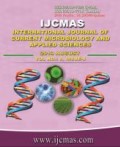


 National Academy of Agricultural Sciences (NAAS)
National Academy of Agricultural Sciences (NAAS)

|
PRINT ISSN : 2319-7692
Online ISSN : 2319-7706 Issues : 12 per year Publisher : Excellent Publishers Email : editorijcmas@gmail.com / submit@ijcmas.com Editor-in-chief: Dr.M.Prakash Index Copernicus ICV 2018: 95.39 NAAS RATING 2020: 5.38 |
Biologically active product more appropriately called as “microbial inoculants” contains active strength of selective microorganisms like bacteria, algae, fungi; alone or in combination helps in increasing crop productivity by biological nitrogen fixation. Biological nitrogen fixation , the second most important biological process on earth after photosynthesis involves conversion of atmospheric nitrogen (N2) to ammonium, a form of nitrogen that can be utilized by plants The rhizobia are a group of Gram-negative bacteria that form species-specific symbioses with legume plant. The Rhizobium-legume symbiosis is superior to other nitrogen fixing systems as symbiotic nitrogen fixation is an important source of nitrogen, and the various legume crops and pasture species often fix as much as 200 to 300 kg nitrogen per hectare. Thus emphasis should be given for establishment of efficient symbiotic N2-fixing systems in legumes. The work pertaining to different aspects on legume - Rhizobium symbiosis have been covered in the review. Biological nitrogen fixation is estimated to be approximately 150 to 200 million tonnes annually on the earth’s surface. Biological nitrogen fixation contributes about 100 million tons of nitrogen for terrestrial ecosystems, 30 to 300 million tons for marine ecosystems and 20 million tons from chemical fixation due to atmospheric phenomena. Besides the unique nature of association, the importance of the association from the point of view of nitrogen economy and soil fertility also seems to have generated so much interest on the subject within the scientific community. Most researches’ results indicate that Rhizobium inoculation is promising biofertilizer because it is cheap, easy to handle and improves plant growth. Therefore, legume-rhizobia symbiosis can provide easy and inexpensive way to enhance soil fertility and improve crop production.
 |
 |
 |
 |
 |